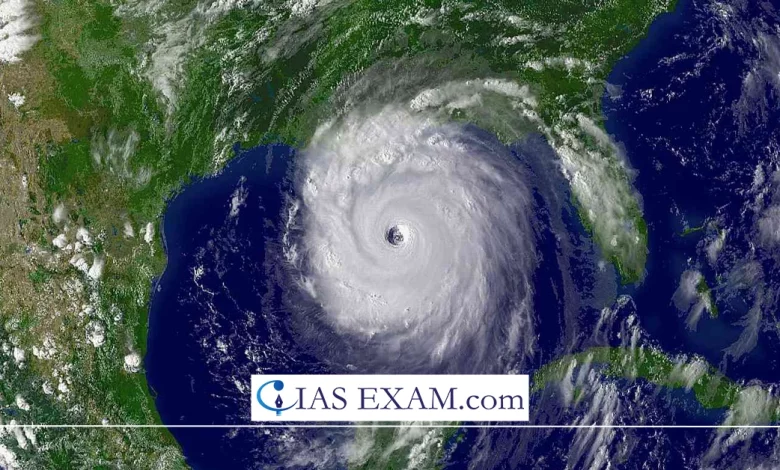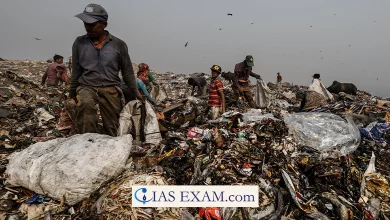New Category for Intense Tropical Cyclones
Syllabus: Geography [GS Paper - 1]

Context
Global warming is resulting in an increase in the power of tropical storms. Some propose adding another Category 6 for cyclones with winds higher than 309 km/h due to category 5’s 252 km/h threshold having been breached on several occasions giving birth to a new category of Intense Cyclones. Tropical cyclones originate over warm oceans, delivering destructive winds, heavy precipitation, and high storm surges which lead to major coastal disasters.
Cyclone and it’s Category
- A cyclone is a storm formed by strong winds moving around the centre of a low-pressure area. Different regions even use different names for these storms including: hurricane, typhoon, or tropical cyclone. They form over the warm ocean waters and present as the causes of damage to coastal areas through strong winds, heavy rains and storm surges.
- The classes utilised in the cyclone severity scale differ depending on the scale.
- The Saffir-Simpson Hurricane Wind Scale, widely seen in the tropical Atlantic and northeastern Pacific area as well, sorts the hurricanes into five main categories indicating the magnitude of the sustained wind speed.
- category 1 involves the emission of 74-95 miles per hour (88 – 153 km / h) with wind speeds.
- Category 2 storms have speeds of over 150 kilometres per hour (96 mph).
- Category 3 hurricanes have winds ranging between 111 and 129 mph. They can blow at speeds of up to 178 miles per hour.
- Category 4 hurricanes whose wind velocity range between 130 mph and 156 mph is doomed for significant damage because of their monstrous strength.
- Category 5 hurricanes are classified when they bear wind speed of at least 157 mph / 252 km/h or higher.
- In the northwestern Pacific, typhoons’ size classification is different from the scale used in the western Pacific for the same category of typhoons. An instance here, the Japan Meteorological Agency has its own scale for typhoons which is 1 to 5 while the Australian Bureau of Meteorology has a wind scale of category 1 to 5 for tropical cyclones.
- These classifications serve the purpose of officials and people to recognize the surplus strength of cyclones and to take actions accordingly whether for their operating side or saving side. Although these classes depend on the wind speeds, they might not take into account the precipitation quantity, storm surges, and other phenomena.
Why need for Category 6
- When monitoring the development of cyclones in the Pacific, the recent report indicates more powerful storms than those of Category 5 have caused experts to recommend a new Category 6 to represent typhoons with speeds exceeding 309 km/h due to climate change.
- An analysis of the data from 197 Category 5 Cyclones (1980-2012) shows the increasing number of them, including one or two of them that exceeds proposed limits.
- The numerical models tend to show more extreme events. It is probable that the inclusion of Category 6 could lead to an increased awareness and preparedness for stronger storms.
- As vulnerable regions, like the Caribbean, may already be under the threat of Category 6 hurricanes, it is often the other ones, like the North Indian Ocean, which may be targeted.
- The resulting reassessment shall mean recalculation of disaster plans and improvement of the early warning systems.
What made it to increase in Intensity of Cyclone
- Global average temperature has risen by 1.10°C due to oceans’ warming caused by the greenhouse gases’ effect. This warming brings an upward trend on genesis of tropical cyclones, including their frequency and danger level.
- With every degree of warming, the road of hurricane wind strengths rises by 12% and winds get three times stronger which is damaging.
- Cyclones show a continuing trend of moving towards the poles, being formed at more northern latitudes and strengthening suddenly.
- The tropical cyclone Freddy lasted for 37 days in all, causing a new record for approaching land as a longer duration event with rains continuing to pour.
Conclusion
- As the intensity of cyclones increases because of global warming, the need for new Category 6 classification becomes essential. The rate of highly destructive hurricanes surpassing the Category 5 level marks the importance of advance preparedness and awareness programs. Differing from the past, the risk of disastrous consequences in the current case is incremented in specifically endangered places.
- Therefore, changes in the disaster management system and development of early warning systems are extremely crucial. The identification and solution to the changing threats are the most important in the saving of communities from the destructive effects of stronger cyclones.
Source: The Hindu
Read More: Twin cyclone in Indian Ocean , Changing landscape of Cyclone formation
UPSC Mains Practice Question
Q.Discuss the implications of global warming on tropical cyclones and the proposed introduction of a new Category 6 classification. Evaluate the necessity and potential benefits of this proposal in mitigating the risks posed by intensified cyclones. Support your answer with relevant examples and data.





.png)



